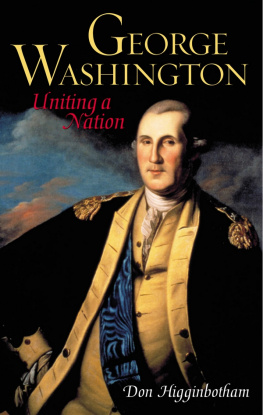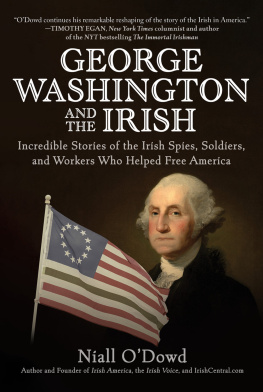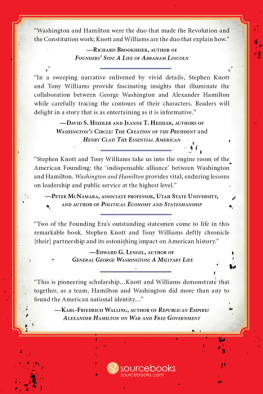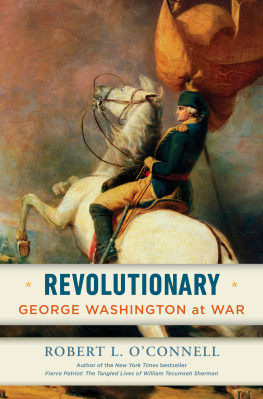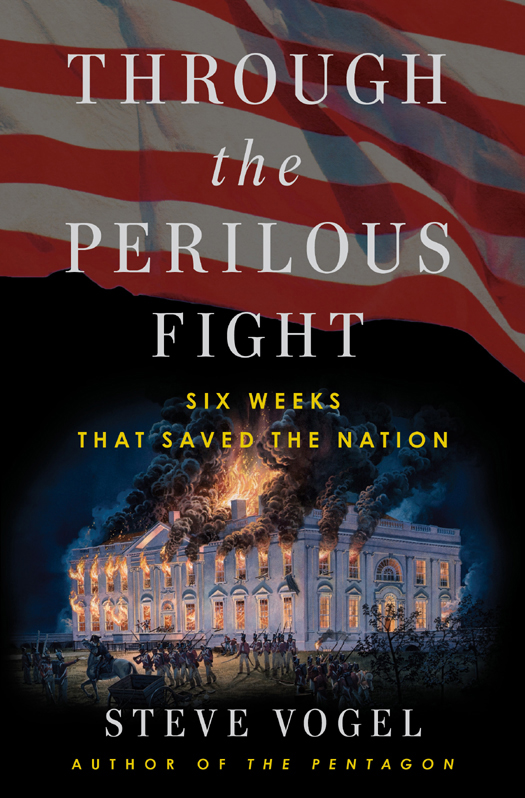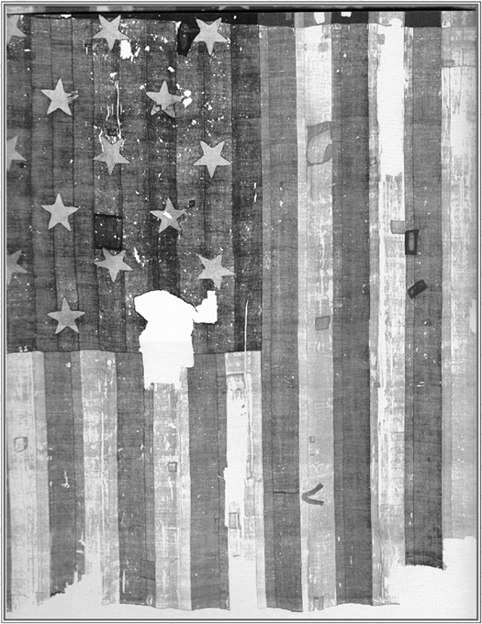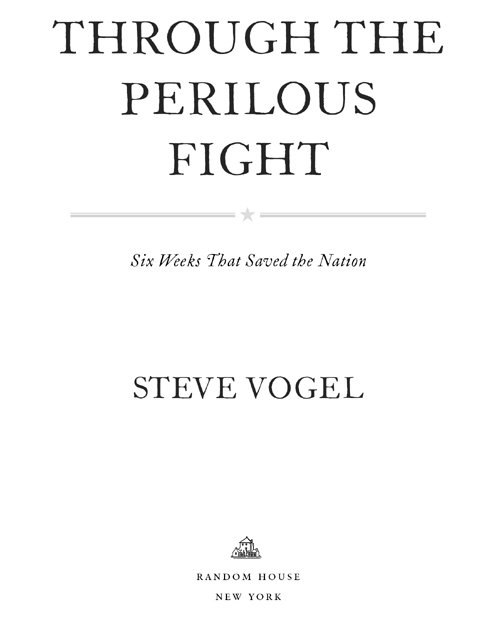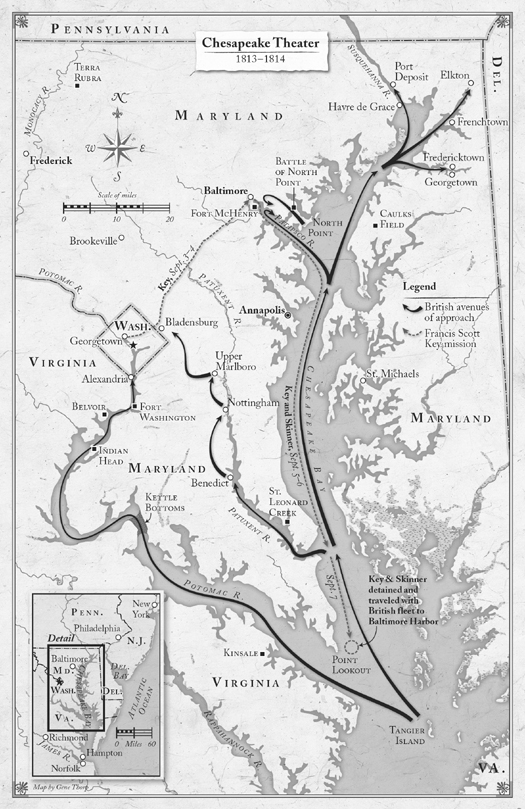Two hundred years after the battle, tattered and frail, the Star-Spangled Banner seemed more powerful than ever.
All rights reserved.
Published in the United States by Random House, an imprint of The Random House Publishing Group, a division of Random House, Inc., New York.
Random House and colophon are registered trademarks of Random House, Inc.
Excerpted from Through the Perilous Fight by Steve Vogel, copyright 2013 by Steve Vogel. Published by Random House, an imprint of The Random House Publishing Group, a division of Random House, Inc., New York.
Nations will seldom obtain good national anthems by offering prizes for them. The man and the occasion must meet.
To download a PDF of this map, click here.
LIST OF ILLUSTRATIONS
The Star-Spangled Banner (Armed Forces History Division, National Museum of American History, Smithsonian Institution)
The Chesapeake Theater map (Gene Thorp/Cartographic Concepts, Inc.)
George Cockburn engraving from Edward Pelham Brentons Naval History of Great Britain, published in 1824 (Library of Congress)
Admiral Cockburn Burning and Plundering Havre De Grace on the 1st of June 1813 by William Charles (Anne S. K. Brown Military Collection, Brown University Library)
Etching of Francis Scott Key from a newspaper clipping (Library of Congress)
The Key home in Georgetown by John Ross Key (Courtesy of the Diplomatic Reception Rooms, U.S. Department of State)
James Madison portrait by Joseph Wood (Virginia Historical Society)
Joshua Barney portrait by Stanislav Rembski (Naval History and Heritage Command)
Sketch of the British blockade at the mouth of the Patuxent River by Commodore Joshua Barney in August 1814 (National Archives)
Portrait of Major General Robert Ross (Stephen Campbell)
Vice Admiral Sir Alexander Cochrane engraving from Brentons Naval History of Great Britain (Naval History and Heritage Command)
Advance on the Capital in 1814 map (Gene Thorp/Cartographic Concepts, Inc.)
A View of the Capitol Before it was Burned Down by the British, by William Birch (Library of Congress)
Sketch of Brigadier General William Winder by Benson J. Lossing ( The Pictorial Field-book of the War of 1812 )
Map showing the route of the British from the Patuxent River to Washington, published in 1818 by William James (The Albert H. SmallGeorge Washington University Collection)
James Monroe, painted circa 1819 by Samuel F. B. Morse (Library of Congress)
Joshua Barney sketch of a Chesapeake flotilla barge (National Archives)
Map depicting march of the British Army from Benedict to Washington by Benson J. Lossing ( The Pictorial Field-book of the War of 1812 )
Photograph of Gen. George De Lacy Evans by Roger Fenton (Library of Congress)
Engraving of Commodore Joshua Barney by Cephas G. Childs and Thomas Gimbrede ( A Biographical Memoir of the Late Commodore Joshua Barney )
Secretary of the Navy William Jones (Naval History and Heritage Command)
Final Stand at Bladensburg by Charles H. Waterhouse (Art Collection, National Museum of the Marine Corps, Triangle, Virginia)
A British Congreve rocket that burned the Waller farmhouse in Marylands Eastern Shore during a raid led by Capt. Peter Parker in August 1814 (National Park Service).
Engraving of Dolley Madison based on a portrait by Gilbert Stuart in 1804 (Library of Congress)
Paul Jennings photograph taken in the 1850s (Estate of Sylvia Jennings Alexander)
Mural in the Capitol depicting its burning by the British, painted by Allyn Cox in 1974 (Office of the Architect of the Capitol)
The Fall of Washington map (Gene Thorp/Cartographic Concepts, Inc.)
Watercolor of Washington Navy Yard by William Thornton, circa 1815 (Library of Congress)
The Presidents account book, later returned to the Library of Congress (author photo)
Capture of the City of Washington, engraving from Rapins History of England, published in London in 1815 (National Archives)
George Cockburn, mezzotint of circa 1817 painting by John James Hall (Library of Congress)
Captain Thomas Tingey, commandant of the Washington Navy Yard (Naval History and Heritage Command)
The U.S. Capitol after burning by the British, sketch by George Munger in 1814 (Library of Congress)
A view of the Presidents house in the city of Washington after the conflagration of the 24th August 1814, hand-colored aquatint by George Munger in 1814 (Library of Congress)
Captain John Rodgers, the senior U.S. naval officer in the war (Naval History and Heritage Command)
A Baltimore clipper, sketch by Benson J. Lossing ( The Pictorial Field-book of the War of 1812 )
General Samuel Smith, 1817 portrait by Rembrandt Peale (Maryland Historical Society, image ID CA681)
Johnny Bull and the Alexandrians, 1814 political cartoon by William Charles (Library of Congress)
Commodore Oliver Hazard Perry, engraving by Henry Meyer from portrait by John W. Jarvis (Library of Congress)
Captain David Porter in oil portrait, possibly by John Trumbull (Naval History and Heritage Command)
Francis Scott Key portrait by Joseph Wood, circa 1825 (Walters Art Museum)
John Stuart Skinner in 1825 ( The Baltimore Sun )
Sketch of the Potomac battle by William Bainbridge Hoff (Naval History and Heritage Command)
Assembly of the Troops Before the Battle of Baltimore, oil by Thomas Ruckle, Sr., circa 1814 (Maryland Historical Society, image ID 1879.2.1)
Joseph Hopper Nicholson, in an 1810 engraving by Charles Balthazar Julien Fevret de Saint-Memin (Maryland State Archives)
Sketch of Brigadier General John Stricker by Benson J. Lossing ( The Pictorial Field-book of the War of 1812 )



